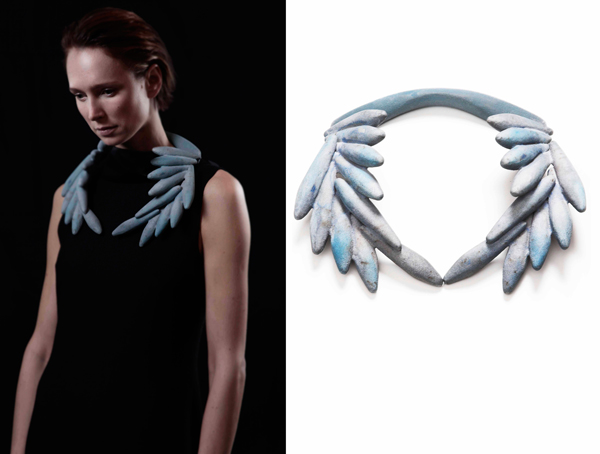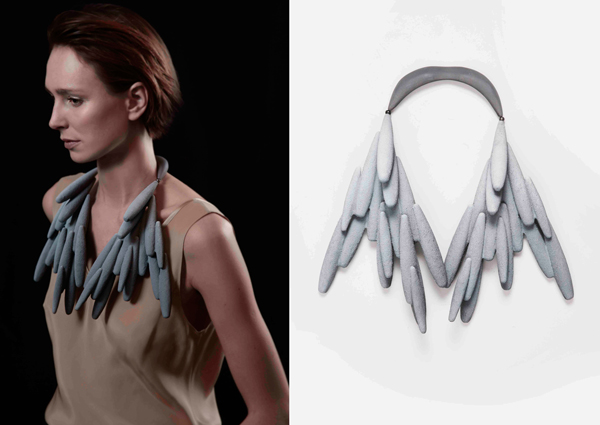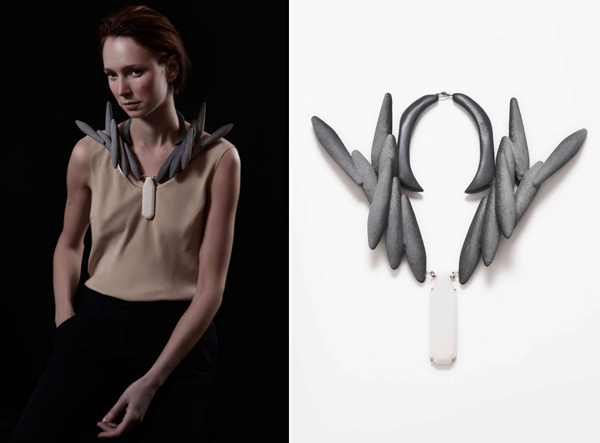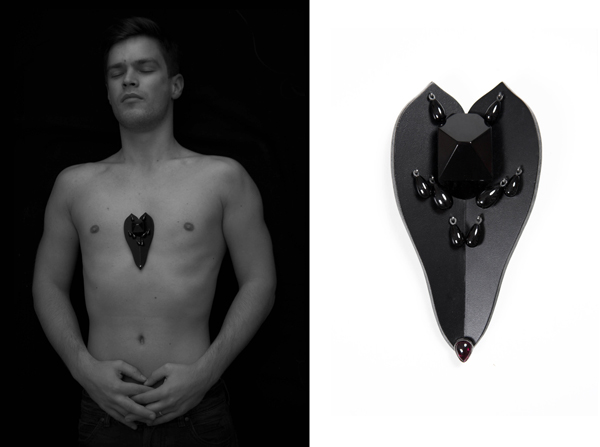
Aaron Decker: Tanel Veenre is an intensely sharp artist. His scope of work encompasses a deep search into oneself, not literally, but through the winding road of following one’s mind and hands to make the path less traveled easier to navigate. With sensitivity to materials, color, and scale, he works like a maestro constructing visionary worlds through jewelry. Tanel will be exhibiting My Kingdom during Schmuck (March 8–10, 2013) at The Foundry in Munich, Germany (Schleißheimer Str 72).
How did you come to jewelry? What is your artistic past?
Tanel Veenre: There have been four or five generations of music teachers and musicians in my family. I think my father hoped I would become a musician, but I’ve felt a strong urge to make things with my hands since I was very young. If I picture myself as a child, I see myself on the floor drawing, just sitting there drawing. I would make piles of drawings, and it was decided.

Aaron Decker: Tanel Veenre is an intensely sharp artist. His scope of work encompasses a deep search into oneself, not literally, but through the winding road of following one’s mind and hands to make the path less traveled easier to navigate. With sensitivity to materials, color, and scale, he works like a maestro constructing visionary worlds through jewelry. Tanel will be exhibiting My Kingdom during Schmuck (March 8–10, 2013) at The Foundry in Munich, Germany (Schleißheimer Str 72).
How did you come to jewelry? What is your artistic past?
Tanel Veenre: There have been four or five generations of music teachers and musicians in my family. I think my father hoped I would become a musician, but I’ve felt a strong urge to make things with my hands since I was very young. If I picture myself as a child, I see myself on the floor drawing, just sitting there drawing. I would make piles of drawings, and it was decided.
I am not sure how jewelry entered the picture. In the end, I think the choices you make as a late teenager are so intuitive and emotionally driven. One of my other choices would have been semiotics or history, mainly because I was platonically in love with a guy who was really into history. I also thought about graphic art or fashion mainly because of my friends. Jewelry felt like I was being myself, and it was different from all my other friends.
When you first go into jewelry, you think of classical pieces seen in paintings or pieces your grandmother may have worn. So you enter school with this image in your head, and then that all changes 180 degrees.

Tanel Veenre: We had a very strong department at the Estonian Academy of Arts because of Kadri Mälk. She is highly intelligent and insightful. There is nothing random in our department. Everything is strongly felt and thought through. It is like a tree or a building. You start at the roots or the foundation, and then you go through layers, growing and growing until you reach the sky. It’s very ideological. I felt very comfortable in this sort of environment.
For me, my hands have always been a tool. I use my hands, and they figure out things as they go. I am very sensory based and intuitive in my working method, and my hands are like antennas for me. It seems that they have their own wisdom. So, to understand myself better, I have to work a lot.
What do you mean by working a lot? Are you speaking about volume of work or conceptual strides?
Tanel Veenre: I always push myself to have a lot of experiments on the table, to make a lot to see. I have always worked this way. I would have a table full of pieces while other students had two or three. So, Kadri thought that the Gerrit Rietveld Academie would be a suitable choice for me to attend as an exchange student for one year. But, I got lost there somehow. I had many communication issues there. I felt like a human being without a tongue or hands. I was quite unhappy in that context. But the people were nice, and reflecting on the experience, I now see that it gave me a great understanding of differences.

Tanel Veenre: I think that switching environments teaches empathy. When I was at the Rietveld Academie, I was alone, I was lost, I had no money, and there was no Internet. (In 1997, it was still a rare miracle.) So, I was really cut off from my environment. I was so young and miserable, but this gave me the sense that I found myself very different. Then, I began to see the whole of things as a collection of differences. It was not merely the idea that because you are away from home you gain new perspective. Of course, this is undoubtedly true. But what I felt was something more. I came to believe that uncomfortable situations might provoke strong ideological shifts.
Looking at your experience at Rietveld Academie and understanding the differences you noticed—from a teacher’s perspective, the methodology and such, how would you characterize your teaching method?
Tanel Veenre: I think my main curiosity is humans. I am highly curious about all people. I think the basis for teaching (and all other human relations) is empathy. I am always trying to get under another’s skin and see into another’s soul. I try to get into someone’s shoes and see myself teaching from there. I believe in organic growth and that each person has his own rhythm. I try to sense the natural way a person operates and try to go with it. Some go easily, without any talks or incubation, and come into their own quite fast.
Our department is like a sauna. We cheer for the happiest moments and grieve in the worst ones. We are a very intimate department. I have not seen another department like ours anywhere. Many are much colder. But here, students have access to the teachers all day, and it is quite easy just to ask for them.

Tanel Veenre: I think humanity is the most important thing to take from our department. I cannot think of artistic attributes. I would say that kindness, empathy, and caring are very important.
Do you think there is a fear in contemporary jewelry right now that it is all the same?
Tanel Veenre: I can only talk about my fears and hopes. I think this topic has been coming up for the past few years. What is my response to this? Somehow, I also see that people are trying to redefine what it means to be local, especially in the characteristics of the work. Geography is very significant to this. People are looking at their origins again as spaces to see and reflect. But at the end of the day, there are strong individuals with personal worldviews that make sense. Then, it should be more than geography. It should be a mixture of personal experiences, education, and the most random influences—even the bird singing behind the window in just the very right moment—that make an important impact.
Are we all the same in the future? We cannot judge the things coming, only the things that are and have been. I am optimistic, come what may. I am really curious about what’s coming. How we are dealing with artificial intelligence and all these high scientific tools we have created. If we will all be the same, if there is no art anymore, it should be fine. Each process and each development is so human that it would be hypocritical to say it’s bad. It all comes from us. Think about that. Earth is about 4.6 billion years old, our race is about 200,000 years old, and human civilization is around 15,000 years old. We have only been here for a blink of an eye. Why do we think that the world we live in now is something eternal? Why do we think that art is eternal?
Pertaining to you as an artist, how would you describe your work?

The most important thing is just to create, without any words. Creating connections and meanings. Creating my imaginary world that has something unexpectedly significant around every corner. I am probably constructing my idea of the ultimate, perfect castle. I see that I am getting closer and closer with every trace and brick. Of course, every movement I make is a dialogue with all created before.
I have crazy drive all the time. I see myself as a living laboratory (with a franticly pumping heart). I can burn my fingers and get poisoned by resins during the process, and I don’t even notice it.
I have lately been thinking about the strange phrase “artistic style.” Can style be artistic? Aren’t these opposites? This seems more like a demand of the art system (market). So, I try to clean my inner table as often as possible and start from tabula rasa. Blank slate. I am really intrigued to see if my laboratory can make things in this manner. And it’s really important to have a high level of superficiality during this experiment!
How would you describe your process, where the work goes, and afterthoughts?
Tanel Veenre: I think of it as playing a piano with five different hands. I am carving wood, then the next moment casting resin, then stone setting, then metal, and maybe bone. I am really exploring different territories of jewelry—big body pieces, extravagant fashion items, commercial jewelry design, purely conceptual pieces created only for one photo shoot, sentimental jewelry for loved ones. There is no strategic plan. I just go where it takes me. I have an urge and trust myself, and I think that I haven’t had a crisis.
Maybe after a big solo show I am a bit tired and avoid my workshop for five days, but on the sixth day I run there. There is so much happening inside that I need to reflect on it with my hands. I have to get it out. This is something like being in love—a huge curiosity with a subject, getting as much of it as you can, a constant thrill. Something you live with and cannot separate.

Tanel Veenre: I don’t care. I really don’t care about after the work. I am just done and running to the next idea. I think it’s a waste of time to glorify the last works. I move forward. With most of the work I’ve done, I feel distanced instantly once it’s ready. I might even take a five-year-old piece and destroy it to reinvent it.
I believe that creating has lot to do with solitude. First, I create things to reflect on my thoughts. When I meet other souls through my creations, I believe it’s like trying to make friends. It’s so great to have friends!
Do you think there is a strong Estonian spirit in your work?
Tanel Veenre: Although I believe less and less in nationalistic generalizations, I think there is still a glimpse of the Estonian sky in my pieces. I look around, and yes—we have a lot of black and a lot of white. I was told by my gallerist Stefan Friedmann (Ornamentum Gallery) that the way Nordic people use color is with a lot of heart. It takes courage to be bright among darkness!
But personally, I think my work is not the best example to describe the Estonian school because I am traveling a lot in my mind, looking at different cultures and different mindsets.
I think artists are really happy that you are asking all these questions. Explaining to get another view. It might even influence the pieces I start to make tomorrow! But then again, we shouldn’t forget that it is just words.

Tanel Veenre: Yes. It’s just that art can occupy endless mental space. Inside that space, you can do anything. If you got into another person’s heart and soul, you can use that space to tell a story. Is there a reason you ask that? Why did you specifically pick that quote?
Well, I thought it was an interesting way to talk about making jewelry. So poetic. Can you talk to this idea more?
Tanel Veenre: Sometimes when I sit at my workbench, all suddenly becomes clear, and I say, “Yes. I have to make it this way!” It becomes so huge. It is everything. All encompassing. And when it’s done, it’s not so clear anymore. It has lost its clarity during birth. So, I have to start all over again. And again. Again.
Thank you.




